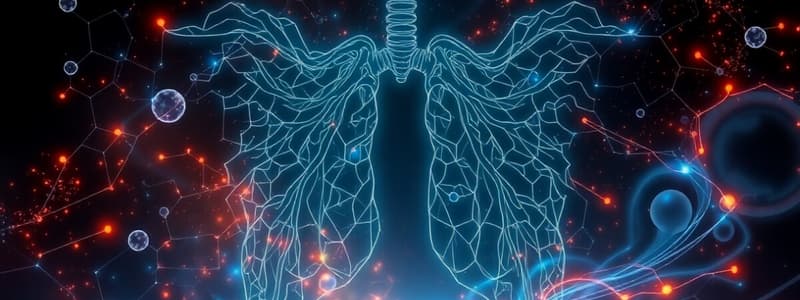Podcast
Questions and Answers
Why do parents insist on regular eating?
Why do parents insist on regular eating?
- It increases circulation of blood.
- It helps in avoiding muscle cramps.
- It prevents anaerobic respiration.
- Food provides stored energy for respiration. (correct)
What is produced during anaerobic respiration in yeasts?
What is produced during anaerobic respiration in yeasts?
- Alcohol (correct)
- Carbon dioxide
- Lactic acid
- Glucose
What causes muscle cramps after heavy exercise?
What causes muscle cramps after heavy exercise?
- The oxygen levels in the blood
- The accumulation of glucose
- The accumulation of lactic acid (correct)
- The breakdown of carbon dioxide
What allows muscle cells to respire anaerobically?
What allows muscle cells to respire anaerobically?
What is the effect of a hot water bath or a massage on muscle cramps?
What is the effect of a hot water bath or a massage on muscle cramps?
What happens when there is limited oxygen supply during heavy exercise?
What happens when there is limited oxygen supply during heavy exercise?
What is the end product of the complete breakdown of lactic acid?
What is the end product of the complete breakdown of lactic acid?
Why is it essential to breathe regularly?
Why is it essential to breathe regularly?
What process is used for food breakdown when oxygen is not available during heavy exercise?
What process is used for food breakdown when oxygen is not available during heavy exercise?
What is the main difference between aerobic and anaerobic respiration?
What is the main difference between aerobic and anaerobic respiration?
What role does oxygen play in cellular respiration?
What role does oxygen play in cellular respiration?
Which respiratory organ is used by earthworms for gas exchange?
Which respiratory organ is used by earthworms for gas exchange?
During inhalation, what happens to the lungs?
During inhalation, what happens to the lungs?
Which process involves the breakdown of food without the use of oxygen?
Which process involves the breakdown of food without the use of oxygen?
Why do people breathe faster during physical activities like running?
Why do people breathe faster during physical activities like running?
How do leaves exchange gases?
How do leaves exchange gases?
What term describes organisms that can survive without air?
What term describes organisms that can survive without air?
What initiates an athlete's faster breathing rate after a race?
What initiates an athlete's faster breathing rate after a race?
What is the primary energy source for cellular functions in organisms?
What is the primary energy source for cellular functions in organisms?
Which organisms have similar respiratory organs and processes to humans?
Which organisms have similar respiratory organs and processes to humans?
What is the end product of glucose breakdown during aerobic respiration?
What is the end product of glucose breakdown during aerobic respiration?
Which test-tube would likely have the highest concentration of CO2 with a snail and a plant?
Which test-tube would likely have the highest concentration of CO2 with a snail and a plant?
During rest, a person's breathing rate is typically:
During rest, a person's breathing rate is typically:
What is the purpose of sneezing in the respiratory system?
What is the purpose of sneezing in the respiratory system?
What is the significance of cellular respiration in living organisms?
What is the significance of cellular respiration in living organisms?
Which part of the human respiratory system is primarily responsible for trapping dust and other particles?
Which part of the human respiratory system is primarily responsible for trapping dust and other particles?
What should you do when sneezing to prevent the spread of particles?
What should you do when sneezing to prevent the spread of particles?
When measuring the size of the chest during a deep breath, what are you assessing?
When measuring the size of the chest during a deep breath, what are you assessing?
Which structure in the respiratory system helps to increase our lung capacity when expanded?
Which structure in the respiratory system helps to increase our lung capacity when expanded?
What does the activity involving a plastic bottle and balloons demonstrate?
What does the activity involving a plastic bottle and balloons demonstrate?
What role do the hairs in the nasal cavity play in respiratory health?
What role do the hairs in the nasal cavity play in respiratory health?
Which activity demonstrates how air moves through the lungs?
Which activity demonstrates how air moves through the lungs?
What happens to the diaphragm during inhalation?
What happens to the diaphragm during inhalation?
Which of the following gases are expelled during exhalation?
Which of the following gases are expelled during exhalation?
What occurs to the ribs during exhalation?
What occurs to the ribs during exhalation?
How does the chest size change during inhalation compared to exhalation?
How does the chest size change during inhalation compared to exhalation?
What is observed when exhaled air is blown onto a mirror?
What is observed when exhaled air is blown onto a mirror?
What demonstration can be used to understand the expansion of the lungs?
What demonstration can be used to understand the expansion of the lungs?
What is the effect of inhalation on lung volume?
What is the effect of inhalation on lung volume?
What mechanism primarily drives the process of breathing?
What mechanism primarily drives the process of breathing?
What do the balloons in the breathing model represent?
What do the balloons in the breathing model represent?
What does the rubber sheet in the breathing model simulate?
What does the rubber sheet in the breathing model simulate?
Which organisms do not have lungs but utilize alternative structures for gas exchange?
Which organisms do not have lungs but utilize alternative structures for gas exchange?
Which statement is true about the tracheae in insects?
Which statement is true about the tracheae in insects?
What happens to carbon dioxide in the gas exchange process in insects?
What happens to carbon dioxide in the gas exchange process in insects?
Which breathing method is suggested to increase lung capacity?
Which breathing method is suggested to increase lung capacity?
What does lime water indicate when exhaled air is bubbled through it?
What does lime water indicate when exhaled air is bubbled through it?
What advantage does the use of tracheae provide to insects?
What advantage does the use of tracheae provide to insects?
Flashcards
Respiration
Respiration
The process of breaking down food to release energy. Occurs in both plants and animals.
Anaerobic Respiration
Anaerobic Respiration
The process of breaking down glucose (sugar) in the absence of oxygen. Produces less energy than aerobic respiration.
Fermentation
Fermentation
A type of anaerobic respiration that occurs in some organisms, such as yeast. Produces alcohol as a byproduct.
Lactic Acid
Lactic Acid
Signup and view all the flashcards
Breathing
Breathing
Signup and view all the flashcards
Circulation
Circulation
Signup and view all the flashcards
Aerobic Respiration
Aerobic Respiration
Signup and view all the flashcards
Oxygen Deficiency
Oxygen Deficiency
Signup and view all the flashcards
What is a cell?
What is a cell?
Signup and view all the flashcards
What is glucose?
What is glucose?
Signup and view all the flashcards
What is Carbon Dioxide?
What is Carbon Dioxide?
Signup and view all the flashcards
Cellular Respiration
Cellular Respiration
Signup and view all the flashcards
What is energy?
What is energy?
Signup and view all the flashcards
Inhalation
Inhalation
Signup and view all the flashcards
Exhalation
Exhalation
Signup and view all the flashcards
Diaphragm
Diaphragm
Signup and view all the flashcards
Chest Expansion during Inhalation
Chest Expansion during Inhalation
Signup and view all the flashcards
Chest Contraction during Exhalation
Chest Contraction during Exhalation
Signup and view all the flashcards
Oxygen
Oxygen
Signup and view all the flashcards
Carbon Dioxide
Carbon Dioxide
Signup and view all the flashcards
Moisture in Exhaled Air
Moisture in Exhaled Air
Signup and view all the flashcards
Respiratory Organs
Respiratory Organs
Signup and view all the flashcards
Stomata
Stomata
Signup and view all the flashcards
Lungs
Lungs
Signup and view all the flashcards
Pharynx
Pharynx
Signup and view all the flashcards
Trachea
Trachea
Signup and view all the flashcards
Nasal Passage
Nasal Passage
Signup and view all the flashcards
Oral Cavity
Oral Cavity
Signup and view all the flashcards
Nasal Hairs
Nasal Hairs
Signup and view all the flashcards
Rubber sheet in the breathing model
Rubber sheet in the breathing model
Signup and view all the flashcards
Balloons in the breathing model
Balloons in the breathing model
Signup and view all the flashcards
Inhaled air
Inhaled air
Signup and view all the flashcards
Exhaled air
Exhaled air
Signup and view all the flashcards
Spiracles
Spiracles
Signup and view all the flashcards
Gas exchange
Gas exchange
Signup and view all the flashcards
Study Notes
Respiration in Organisms
- Respiration is the process of breaking down food in cells to release energy.
- All living organisms carry out respiration to obtain energy from food.
- During respiration, organisms take in oxygen and release carbon dioxide.
Why do we respire?
- Organisms are made of cells, the smallest structural and functional unit.
- Cells need energy to perform functions like nutrition, transport, excretion, and reproduction.
- The stored energy in food is released during respiration.
- Aerobic respiration involves oxygen in the breakdown of glucose, producing carbon dioxide, water, and energy.
- Anaerobic respiration is the breakdown of glucose without oxygen, producing a different byproduct (e.g., lactic acid in muscles).
Breathing
- Breathing is the mechanism for taking in oxygen-rich air and releasing carbon dioxide-rich air.
- Inhalation brings in air rich in oxygen.
- Exhalation releases air rich in carbon dioxide.
- Breathing is a continuous process.
- The rate of breathing changes based on activities, like during exercise, the breathing rate increases.
Breathing in other animals
- Different animals have varied respiratory mechanisms.
- Some animals, such as insects, use tracheae for gas exchange.
- Others, like earthworms, use their skin.
- Fish use gills.
- Humans and other mammals have lungs.
Breathing under water
- Some animals, like whales and dolphins, breathe air from the surface of the water.
- Some animals, such as fish use gills to extract dissolved oxygen from the water.
Plant respiration
- Plants also respire, taking in oxygen and releasing carbon dioxide.
- Plants exchange gases through pores called stomata.
Exercises
- Various exercises are included to check student understanding of the topic.
Studying That Suits You
Use AI to generate personalized quizzes and flashcards to suit your learning preferences.




